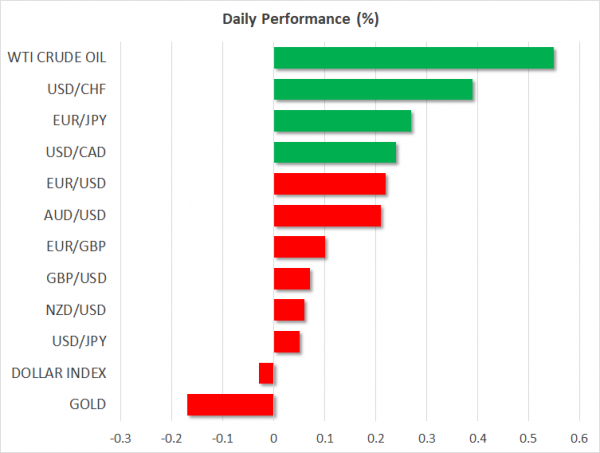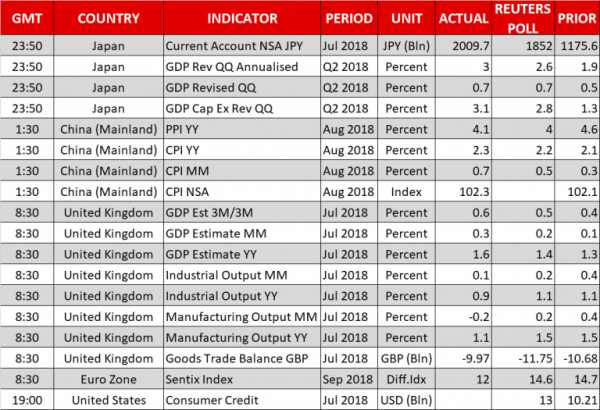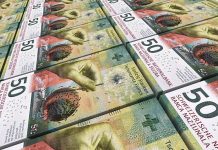Here are the latest developments in global markets:
- FOREX: Sterling crossed marginally below 1.2900 per dollar before better than expected GDP growth figures out of the UK drove the pair up to an intra-day high of 1.2954 amid speculation that British economy could have a good start in the third quarter despite Brexit uncertainties looming in the background. GDP growth clocked in at 0.3% in monthly terms, driving the yearly gauge up to 1.6%. Expectations were for an expansion of 0.2% month-on-month and 1.4% year-on-year. A miss in industrial production data, however, limited further upside in sterling, sending the pair down to 1.2924 (+0.04%). In the Eurozone, the Sentix Investor Confidence Index also disappointed, retreating by 1.3 points to 12.0 in September after rising for the past two consecutive months. Euro/dollar, shrugged off the data, bouncing towards 1.1575 (+0.15%) after slipping to an almost 3-week low of 1.1525 earlier today. The pair probably received a helpful hand from the Italian bond market, which jumped to its highest in six weeks after the Italian Deputy Prime Minister said that the government will do everything to meet external regulations – a message that the government will work to deliver a budget within the EU fiscal limits. Dollar/yen was in a quiet trade last seen at 111.11 (+0.05%) and the dollar index stood at 95.32 (-0.04%) after an upbeat US Jobs report revealed on Friday that in August job positions picked up and wages hit the strongest growth in more than nine years. Still, Trump’s intention to target a bigger list of Chinese products during the weekend maintained a degree of risk aversion in the market. Dollar/loonie was up at 1.3184 (+0.22%), while the antipodean currencies were also enjoying some upside, with aussie/dollar and kiwi/dollar recovering to 0.7121 (+0.23%) and 0.6538 (+0.08%) respectively. Following an inconclusive election outcome in Sweden, the Swedish krona advanced near to a 1-month high versus the euro as analysts believe that no changes in monetary and fiscal stance are expected given that all parties back the country’s strict fiscal framework. Recall that Riksbank (Sweden’s central bank) is planning to deliver a 25bps rate hike in December or February. In Norway, an upward surprise in inflation numbers triggered bullish movements in the Norwegian krona, with euro/krona tumbling by 0.63% and dollar/krona diving by 0.88%.
- STOCKS: European stocks were in the green at 1100 GMT despite inflamed trade tensions weighing on market sentiment. The pan-European STOXX 600 which closed at the lowest since early April on Friday, managed to rise by 0.40% led by financials and utilities, while the blue-chip Euro STOXX improved by 0.42%. The export-oriented German DAX 30 advanced by 0.33%, the French CAC 40 rose by 0.45%, whilst the Italian FTSE MIB was the best performer surging by 2.23%. The British FTSE 100 increased by 0.28%, and the Spanish IBEX 35 was up by 1.13%. In the US, indices tracking futures such as Nasdaq 100, S&P 500 and Dow Jones were poised to open higher but modestly.
- COMMODITIES: WTI crude and the London-based Brent were in the positive territory, trading at $68.1/barrel (0.65%) and $77.39/barrel (0.73%) respectively. On Friday, Baker Hughes reported a smaller number of active US rigs for oil drilling, providing some support to the market, while investors were also concerned about renewed US sanctions against Iranian oil exports taking effect on November 4, two days before US congressional elections. Meanwhile in Washington, the US Energy Secretary, Rick Perry, will be meeting his Saudi Arabian counterpart on Monday, while on Thursday he will be flying to Moscow for discussions with the Russian Energy Minister. Note that this month OPEC and non-OPEC members will be also gathering to talk about the sharing of an output increase agreed in June. In precious metals, dollar-denominated gold recouped earlier losses to edge up to $1,194/ounce (-0.11%) after dropping to a session low of $1,191. However, with the dollar holding onto gains, gold is likely to remain constrained.
Day Ahead: Quiet day in terms of data; US consumer credit and trade tensions eyed
On Monday, the calendar will be light ahead of a busy week with two major central banks deciding on interest rates, the BOE, and the ECB. Both are predicted to keep their rates steady with no major changes in their policy.
In terms of trade tensions, traders still have their attention on the US-China trade war. The US President Donald Trump warned on Friday of applying tariffs on virtually all Chinese imports into the US, that is, another $267 billion of goods in addition to the $200 billion that are already facing the risk of duties. NAFTA discussions will be also eyed as the US and Canada struggle to resolve sticking points to form an agreement that would include Mexico as well.
The US, the world’s largest economy, will see the release of March consumer credit data at 1900 GMT. Credit is predicted to tick higher by $14.50 billion in July from $10.21 billion the preceding month.
Later, at 2245 GMT New Zealand will see the release of the electronic card retail sales for August.
In the Brexit-related news, the UK Prime Minister, Theresa May, is expected to hold a Cabinet meeting this week to discuss the scenario of a no-deal exit from the EU.
In public appearances, Federal Reserve of Atlanta President Raphael Bostic will give a speech at 1600 GMT on the US economic outlook, while Russia’s President Vladimir Putin will meet Japanese Prime Minister Shinzo Abe.















